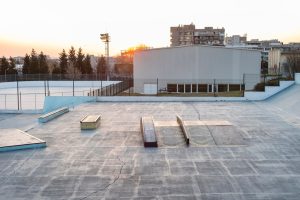
What is the Best Material for a Flat Roof?
One of the most important decisions when installing a flat roof is selecting the material. What is the best material for a flat roof? The answer depends on factors such as climate, building size, and your budget. Here are a few of the most common options:
- EPDM (Ethylene Propylene Diene Monomer): This synthetic rubber membrane is one of the most popular choices for flat roofs. It’s known for its durability, flexibility, and resistance to harsh weather conditions. EPDM can last up to 30 years with proper maintenance.
- TPO (Thermoplastic Polyolefin): This material is highly reflective and offers great energy efficiency. It’s durable and resistant to UV rays, making it an excellent option for warm climates.
- PVC (Polyvinyl Chloride): Another excellent option for flat roofs, PVC is highly durable and resistant to chemical exposure. It’s commonly used for commercial buildings due to its strength and long lifespan.
Flat Roof Types and Their Advantages
There are various flat roof types available, and each offers different benefits. Here’s a breakdown of the most common ones:
- Built-Up Roofing (BUR): Also known as tar and gravel roofs, BUR consists of multiple layers of roofing felt coated with bitumen. It is an affordable and highly durable option for flat roofs, especially in warmer climates.
- Modified Bitumen: This material is a type of asphalt product modified with polymerized rubber or plastic. It’s a highly effective and weather-resistant flat roof solution that works well in colder climates.
- Single-Ply Membranes: These include options like EPDM, TPO, and PVC. They are installed in one layer and provide excellent waterproofing and weather resistance. Single-ply membranes are versatile and suitable for both residential and commercial buildings.
Roofing Materials for Flat Roofs
Selecting the right roofing materials for flat roofs depends on the building’s needs. For example, EPDM is an affordable choice, while PVC offers premium durability. When comparing types of flat roof materials, it’s important to consider factors like ease of installation, cost, durability, and climate suitability.
- EPDM Roofing: Highly resistant to extreme temperatures, it is easy to install and has low maintenance costs.
- TPO Roofing: Reflects sunlight and offers energy efficiency, making it a good option for buildings in sunny regions.
- PVC Roofing: Known for its strength, it is a great choice for commercial properties or areas with high chemical exposure.
Benefits of Choosing the Best Flat Roof System
The benefits of choosing the best flat roof system extend beyond aesthetics. A well-chosen flat roof provides excellent waterproofing, durability, and insulation. Additionally, modern flat roofs can be designed to reflect sunlight and reduce energy costs, making them eco-friendly and cost-effective over time.
Flat roofs also offer flexibility for future expansions, allowing property owners to install solar panels or create rooftop living spaces. For commercial buildings, flat roofs can provide additional storage or HVAC system placement.
Contact Us (954-426-8050) For a Free Roof Evaluation
—
 About Monarch Roofing & Construction
About Monarch Roofing & Construction
Monarch Roofing and Construction proudly serves residential and commercial clients in South Florida with roofing, renovation, and new construction projects. Since 2005, our roofing services have been used all around Florida to meet the needs of homeowners and property managers, extending from Palm Coast to Miami. With our commitment to personalized service and high-quality craftsmanship, Monarch Roofing has established itself as a trusted industry leader dedicated to customer satisfaction. Our extensive service offerings include installation and repair of all types of roofs. As Florida State Certified Roofing and General Contractors, Monarch brings expertise to both residential and commercial projects, emphasizing professionalism, transparency, and cutting-edge technology in their approach. We specialize in hurricane preparedness and participate in the My Safe Florida Home Program, helping homeowners protect their properties from severe weather with expert inspections and recommendations.
> Learn More

 About Monarch Roofing & Construction
About Monarch Roofing & Construction